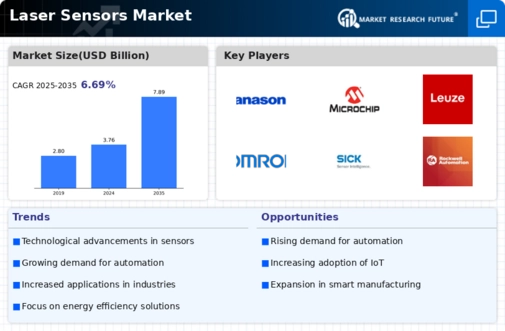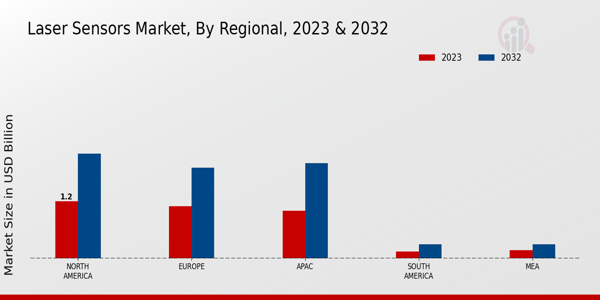Laser Sensors Size
Laser Sensors Market Growth Projections and Opportunities
Several market drivers are responsible for shaping the dynamics and growth pathways of The Laser Sensors Market. A major factor supporting the market is increased automation across industries. Indeed, as industries seek to increase efficiency and accuracy in their operations, the need for laser sensors has grown. These sensors are key elements in automated systems because they provide precise and current measurements, thus promoting better regulation and control. Furthermore, the spiralling dynamics of Industry 4.0 where there is integration of intelligent technologies has also spurred demand for laser sensors because they are important parts in smart manufacturing operations.
In addition, the automotive sector is also a prominent factor for boosting laser sensors market. The automotive industry widely uses laser sensors for collision avoidance, parking assistance and adaptive cruise control. However, as the automotive industry moves towards autonomous vehicles so does the demand for advanced sensing technologies including laser sensors. This will remain the trend, with more focus on increased safety systems and drive towards autonomous cars.
Additionally, the medical industry has become a major laser sensor market driver. These sensors are used in medical devices, diagnostics, and treatment. The excellent precision and accuracy offered by laser sensors have made them a valuable tool in medical procedures, leading to advancements in the patient’s welfare as well as diagnostics. The healthcare sector is rapidly adapting to technological advancements meaning that the demand for laser sensors will register an upward trend.
Key global issues also drive the formation of the laser sensors market landscape. This need has been further enhanced as the idea of sustainability ripples across industries. In these processes, such as industrial automation and building management systems, laser sensors provide high precision measurements which contribute to energy-efficient solutions. Thus, the market is driven by increasing concern about ecological practices as well as green technologies.
Besides these drivers, growth of the market is also affected by challenges and limitations. However, the cost of introducing laser sensor technologies is among such factors. Although such sensors ensure high accuracy and performance, their costs of initial setup can become a fatal issue for small and medium-size companies.
In addition, the technological developments and innovations continue to influence market dynamics. The introduction of miniaturized laser sensors, advancements in sensing capabilities, and the integration of artificial intelligence for data processing are contributing to the market's evolution. As these innovations gain traction, they open up new possibilities for applications in diverse industries, further expanding the market reach.


















Leave a Comment